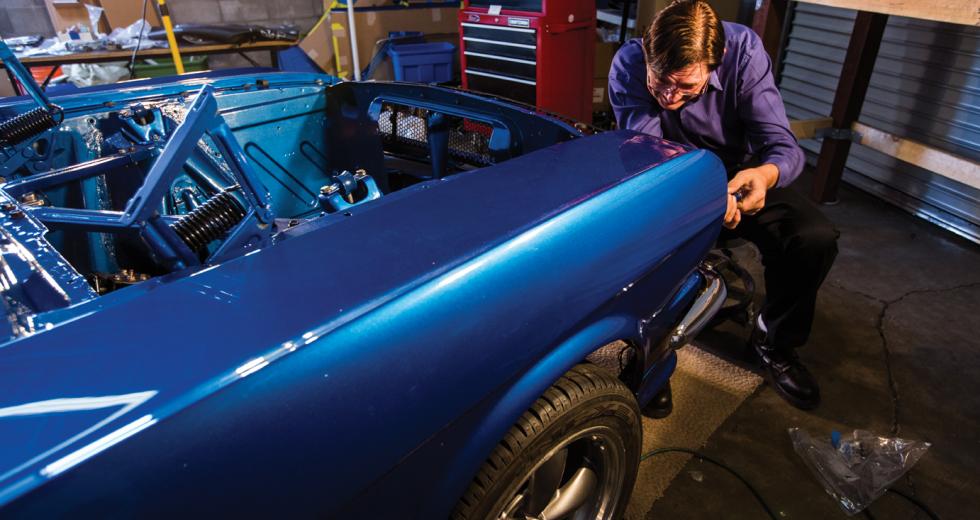Gary Morton has a dream and a car. If his dream comes true, like those of Henry Ford and Karl Benz before him, Morton will turn his prototype into a car company.
But Morton is not looking to build a big assembly plant or an extensive dealer network. His production will be limited to just one model that will offer baby boomers the nostalgia of the muscle cars they drove in their youth alongside their modern commitment to a pollution-free environment.
Classics Gone Green will inject muscle into that environmental ethic by combining Mustangs built nearly a half century ago with high-tech, 21st century electrical power.
“I’m making an environmental car that’s cool,” Morton says.
As his first car takes shape in a Sacramento shop not much bigger than a suburban garage, Morton is building the foundation of his company on one of the most popular models Ford ever made. Introduced in mid-1964, the Mustang revived a sagging car company and created a new look that swept the domestic car industry.
With a long hood and short rear deck, the Mustang created the “pony car” look that turned a boxy Falcon sedan into a sporty head turner, a design duplicated in Chevy’s Camaro and Mopar’s Challenger. It quickly became a top seller, with nearly 400,000 sold in just the first four years and millions more in the decades since, making it one of Ford’s most enduring and popular cars.
By 1970, the Mustang had evolved into a true muscle car as manufacturers used racetrack winners to sell new models. The performance of the early Mustangs, however, was as anemic as the middle-aged sedan hidden under the stylish metal. As a result, the early models, while still prized for their looks, are not high-dollar collector cars, and Morton is basing his business plan on a plentiful supply of cheap models to convert.
“I know people who have been very successful in the electric car business, but I have a different business model,” says Morton, whose high-tech background includes computer system design, robotics and industrial lasers.
The only part of the car that Morton retains is the body, selling off or junking the engine and transmission before rebuilding the car. The power plant is a DC electric motor, which is lighter and more efficient than the more typical AC models, which Morton claims will increase the return on investment. The engine is mated to a standard 5-speed transmission, and all is powered by a lithium battery.
Morton also updates the car with modern suspension and brakes for better handling than the original and a collapsible steering column to improve safety. A stylish air dam on the nose and a full belly pan to enclose the car’s underside improves aerodynamics, which increases driving range. Even the paint is water-based and eco-friendly.
Morton plans to make the car on three performance levels, from an ultra-efficient daily driver to the equivalent of a 200 horsepower hot rod.
“I’m giving someone an almost-new car,” Morton says. “I chose the Mustang because I thought people would want a car that’s cool.” It is also a car that is cheap to rebuild. “I can buy any piece I need from multiple places,” Morton explains. And by focusing exclusively on ’65 to ’69 models, Morton can standardize his production and improve efficiency, even in small volumes.
Of course, electric vehicles are not new. They were among the first cars ever produced, even breaking the magic 100 kilometer per hour speed barrier, about equal to our freeway speed limit, in 1899. Within 20 years, there were approximately a dozen electric car manufacturers, prompted by Thomas Edison and the growing electric utility industry.
The electric models were especially popular among women, since they didn’t require the arm strength to crank-start, and doctors, who could slip soundlessly through town in the middle of the night to make house calls. But the 1912 introduction of electric starters made gasoline-powered cars more convenient and more reliable in cold weather. Mass production turned out gasoline cars at half the price of electrics. They could drive further on a tank of gasoline, which got cheaper as Texas developed its oil fields. Electrics were pushed to the side of the road.
Now, some manufacturers, such as Ford, who phased out the electric car, are embracing it again, motivated by an Environmental Protection Agency-mandated 54.5 mpg, fleet-wide fuel economy standard by 2025. Dozens of major manufacturers and specialty makers are offering electric/gasoline hybrids to comply. Chevrolet’s all-electric Volt was named Motor Trend’s “Car of the Year” in 2010. Tesla’s new Model S sedan claimed the honor for 2013, symbolizing that electrics are here to stay.
By any measure, electrics are a growing market. Nissan upped the ante with its all-electric Leaf, which has already passed the 50,000 sales mark nationally. Pike Research, which specializes in studying clean technology and energy markets, estimates 400,000 annual sales of electric cars by 2020 and a worldwide population of 5.2 million by 2017.
Manufacturers such as Tesla, which offers a high-performance, all-electric sports car and sedan, aim for an even smaller and more specialized market. Tesla recently expanded its assembly line to deliver up to 20,000 cars a year worldwide. Meanwhile, the company has spent more than $400 million in Department of Energy subsidies to develop its power train and battery technology.
Morton, by contrast, believes he can capitalize Classics Gone Green for the cost of one of Tesla’s sexy roadsters and make a profit by selling a handful of cars a year at half of Tesla’s price. “I like those guys because they are pushing the envelope on technology,” he says. “But they’re making a totally different car. I don’t even want those other manufacturers to know I’m here, and I’m not looking to sell thousands of cars.
“My goal is to sell 15 cars a year, and we will make a profit” with a sticker price around $50,000, Morton contends. By classifying his business as a hot rod shop, Morton has avoided costs associated with being a certified manufacturer.
Morton says he gets four or five calls a week from prospective customers. With a prototype scheduled for completion by the beginning of the summer driving season, Morton is confident the demand for his all-electric Mustang will increase.
“I think people want an electric car, but they don’t want it to look like an electric car,” he says. “I think that’s what will get people interested. And as soon as I do a couple of burnouts and put them up on YouTube.”
Recommended For You

It’s Impolite to Squat
EV owners find it increasingly difficult to plug in
Long before it was widely accepted, Sacramento attorney Mike Polis bought his first electric vehicle. He got started with a Toyota Prius, later upgraded to a Nissan Leaf and now drives a white Chevy Volt. On average, he saves more than $3,500 a year over his gas-powered counterparts, he can use the HOV lane as a single occupant and he charges his car for free at work.

Streetcar Named Desire
Funding questions loom over downtown streetcar project
For nearly two decades, local city officials have envisioned a streetcar that would transport residents and visitors across downtown Sacramento.



